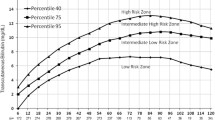Abstract
Objective
To evaluate combined ability of clinical risk factors and transcutaneous bilirubin (TcB) in predicting pathological hyperbilirubinemia (PHB) needing treatment during first week of life in healthy term and late preterm neonates.
Methods
This prospective cohort study included healthy neonates with gestation ≥35 wk and birth weight ≥2000 g. TcB was measured with a multi-wavelength transcutaneous bilirubinometer (Bilichek®) at 30 ± 12 h of postnatal age. Follow-up was conducted as per American Academy of Pediatrics guidelines. For diagnosis of PHB, TcB was measured at each follow-up visit. Serum bilirubin was measured if TcB was >15 mg/dL or within 2 mg/dL of phototherapy cut-off.
Results
Among 462 neonates [birth weight (g; mean ± SD): 2711 ± 431, gestation (wk; median, IQR): 38 (37–39), male: 52%] enrolled in the study, 392 (84.9%) completed followup and PHB was observed in 65 (16.6%) neonates. Discriminant ability of risk model, including both clinical risk factors and TcB, was better than the risk models with clinical risk factors or TcB alone (c-statistic: 0.86 vs. 0.74 vs. 0.77). On logistic regression analysis risk factors found significant were TcB (OR: 1.65, 95% CI: 1.4–1.9), gestation at birth (OR: 0.6, 95% CI: 0.50–0.77) and primiparity (OR: 2.1, 95% CI: 1.1–3.9). A risk prediction score was developed with these three risk factors as ordinal/dichotomous variables. Negative and positive predictive values for score <8 and >12 were 97% and 46%, respectively.
Conclusions
Risk score consisting of TcB, gestation at birth and parity status was able to accurately predict pathological hyperbilirubinemia in derivation cohort of healthy term and late preterm north Indian neonates.
Similar content being viewed by others
References
American Academy of Pediatrics Subcommittee on Hyperbilirubinemia. Management of hyperbilirubinemia in the newborn infant 35 or more weeks of gestation. Pediatrics. 2004;114:297–316.
Ip S, Chung M, Kulig J, et al. An evidence-based review of important issues concerning neonatal hyperbilirubinemia. Pediatrics. 2004;114:e130–53.
Newman TB, Xiong B, Gonzales VM, et al. Prediction and prevention of extreme neonatal hyperbilirubinemia in a mature health maintenance organization. Arch Pediatr Adolesc Med. 2000;154:1140–7.
Keren R, Luan X, Friedman S, et al. A comparison of alternative risk-assessment strategies for predicting significant neonatal hyperbilirubinemia in term and near-term infants. Pediatrics. 2008;121:e170–9.
Kaur G, Srivastav J, Jain S, et al. Preliminary report on neonatal screening for congenital hypothyroidism, congenital adrenal hyperplasia and glucose-6-phosphate dehydrogenase deficiency: a Chandigarh experience. Indian J Pediatr. 2010;77:969–73.
Bhutani VK, Gourley GR, Adler S, et al. Noninvasive measurement of total serum bilirubin in a multiracial predischarge newborn population to assess the risk of severe hyperbilirubinemia. Pediatrics. 2000;106:E17.
Bhutani VK, Johnson L, Sivieri EM. Predictive ability of a predischarge hour-specific serum bilirubin for subsequent significant hyperbilirubinemia in healthy term and near-term newborns. Pediatrics. 1999;103:6–14.
Awasthi S, Rehman H. Early prediction of neonatal hyperbilirubinemia. Indian J Pediatr. 1998;65:131–9.
Agarwal R, Kaushal M, Aggarwal R, et al. Early neonatal hyperbilirubinemia using first day serum bilirubin level. Indian Pediatr. 2002;39:724–30.
Alpay F, Sarici SU, Tosuncuk HD, et al. The value of first-day bilirubin measurement in predicting the development of significant hyperbilirubinemia in healthy term newborns. Pediatrics. 2000;106:E16.
Knudsen A. Prediction of the development of neonatal jaundice by increased umbilical cord blood bilirubin. Acta Paediatr Scand. 1989;78:217–21.
Stevenson DK, Fanaroff AA, Maisels MJ, et al. Prediction of hyperbilirubinemia in near-term and term infants. Pediatrics. 2001;108:31–9.
Okuyama H, Yonetani M, Uetani Y, et al. End-tidal carbon monoxide is predictive for neonatal non-hemolytic hyperbilirubinemia. Pediatr Int. 2001;43:329–33.
Lodha R, Deorari AK, Jatana V, et al. Non-invasive estimation of total serum bilirubin by multi-wavelength spectral reflectance in neonates. Indian Pediatr. 2000;37:771–5.
Contributions
DC designed the study. DC, SJ, SD and SR collected the data. DC analysed data and wrote the manuscript with inputs from SJ and SD. All authors reviewed the final manuscript and made the final decision to submit the manuscript for publication.
Conflict of Interest
None.
Role of Funding Source
None.
Author information
Authors and Affiliations
Corresponding author
Rights and permissions
About this article
Cite this article
Chawla, D., Jain, S., Dhir, S. et al. Risk Assessment Strategy for Prediction of Pathological Hyperbilirubinemia in Neonates. Indian J Pediatr 79, 198–201 (2012). https://doi.org/10.1007/s12098-011-0409-x
Received:
Accepted:
Published:
Issue Date:
DOI: https://doi.org/10.1007/s12098-011-0409-x




